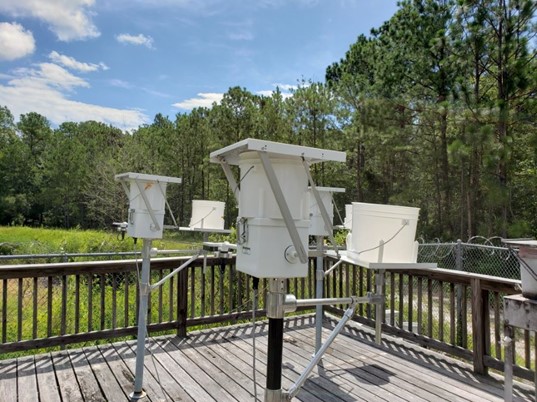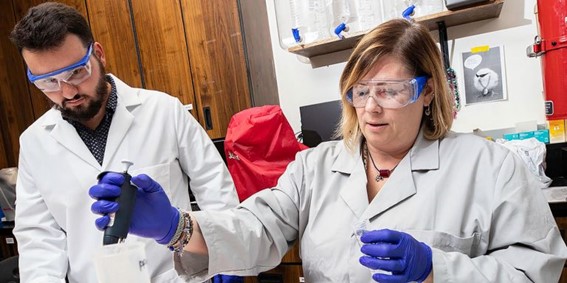North Carolina scientists are working to understand the possible exposure avenues and potential health effects of PFAS.
By Taylor Fitzgerald
The NC Collaboratory’s PFAS Research Initiatives
One of the NC Collaboratory’s larger research initiatives is the NC PFAS Testing Network. The Network was started by the Collaboratory in July 2018 using a $5 million appropriation from the NC General Assembly. The Network has over 100 members comprised of principal investigators from NC State, Duke, UNC-Chapel Hill, UNC-Wilmington, UNC-Charlotte, ECU, and NC A&T.
The purpose of the NC PFAS Testing Network is to bring researchers together to help the state gain a comprehensive understanding of PFAS exposure across North Carolina. Ultimately, the General Assembly mandated that the extensive resources and expertise of the North Carolina system be used to “address the occurrence of PFAS, including GenX, in drinking water resources.”
To achieve this goal, seven teams within the Testing Network set out each to tackle different areas of research related to PFAS. Recent research findings produced by two of these teams: the Air Emissions and Atmospheric Deposition team and the Health Effects Following PFAS Exposure team illustrate the importance of continued PFAS research initiatives.
Studying How PFAS Impacts Air Quality
Dr. Ralph Mead is a geochemist at UNC-Wilmington and head researcher of the Testing Network’s team focused on PFAS impacts and air quality. Dr. Mead and his team at UNC-W analyzed air emissions and atmospheric deposition of PFAS in North Carolina. The purpose of this study is to increase understanding of the composition, distribution and concentrations of PFAS in the air. Currently, little research has been conducted related to the sources, reactions and deposition of airborne legacy and emerging PFAS. This means that there is a lack of data to help inform decision-making surrounding these substances. Dr. Mead and his team are working to change this.

Dr. Mead says that, although the term PFAS makes it appear as if it is only one substance, thousands of varying molecules fall under the category of PFAS. Due to the extremely abundant and diverse amount of PFAS that exist in the world, Dr. Mead explains that there is limited understanding of “the atmospheric occurrence, transport and ultimate fate of a majority of PFAS.” Addressing this prominent issue, Dr. Mead states that his team’s work has “helped to fill this void by quantifying the abundance of PFAS in air and depositional samples through the state of North Carolina.”
Dr. Mead’s study has helped to illuminate two major findings that have changed what was previously known about PFAS in NC. First, it discovered that two major PFAS compounds (PFOA and PFOS) that are no longer produced in North America still exist in atmospheric samples collected throughout different areas of NC. Along with this, the researchers were able to find and quantify various “replacement” or “new generation PFAS” in NC atmospheric samples. Dr. Mead explains that “both of these findings raise even more questions as to the atmospheric lifetime, cycling and ultimate fate of PFAS in North Carolina.”
Understanding the Health Effects of PFAS
Another area of PFAS research with ample room for discovery is understanding how PFAS affects human health. Dr. Jamie DeWitt, a professor of Pharmacology and Toxicology at Eastern Carolina University leads the Testing Network’s team evaluating health effects. Dr. DeWitt and her team are working to assess how PFAS impacts the immune system which ultimately determines the overall health impacts of these substances. Data that is produced by Dr. DeWitt’s team is used to support health assessments and create maximum contamination levels for PFAS in drinking water. “It’s been really exciting to see our research being translated into policies and regulations that will hopefully work to protect people, at least from PFAS in their drinking water,” says Dr. DeWitt.

The team’s findings determined that different types of PFAS have varying immunotoxicity effects. One PFAS studied in particular, Nafion Byproduct (a substance recently discovered in surface and drinking water), was found to suppress the body’s antibody response, a strong sign of immunotoxicity.
Dr. DeWitt explained that the findings of her team’s study and others within the Testing Network have broadened the current understanding of how diverse, widespread and sometimes specific PFAS are. Dr. DeWitt explains “I think one of the really good things about the Collaboratory is that it has opened everybody’s eyes to how diverse PFAS are and how they can oftentimes be very specific to an area where there is a certain industry or practice of applying PFAS to farm fields.”
The Future of Collaboratory PFAS Research
The studies conducted through the NC PFAS Testing Network have each set up amazing groundwork to drive future studies on PFAS in North Carolina. Dr. Mead’s team identified that indoor PFAS, a major exposure location, should be targeted for future studies analyzing different types of atmospheric PFAS. Dr. Karsten Bauman, a professor at the UNC Gillings School of Public Health, explains that PFAS exposure risk indoors mainly comes from inhalation and ingestion from our water and consumer product use. Dr. Barbara Turpin, also a professor at Gillings, is currently leading a study to understand the most common sources that lead to PFAS inhalation found within homes. Dr. Turpin states that “because concentrations may be higher and because we spend most of our time indoors, the indoor environment is an important location for exposure to PFAS.”
Concerning the future of studying the health effects of PFAS, Dr. DeWitt’s team is continuing to focus on how these substances impact the immune system. One area of focus related to the immune system that is particularly relevant today and in the future is Dr. DeWitt’s team’s studies to understand how PFAS impact the COVID-19 vaccine’s response by evaluating how different substances impact the adaptive immune system. Dr. DeWitt explains: “We’re really working hard to understand the molecular mechanisms by which PFAS inhibit the body’s ability to make antibodies against the [COVID-19] vaccine.” The development of these studies is crucial as the Collaboratory continues to address COVID-19 in the state.
The state budget approved by the General Assembly in November 2021 provided more than $14 million in research funding to the Collaboratory to continue and expand PFAS research by university researchers. The results of this ongoing work are shared with policy-makers, public health leaders and the public for the purposes of making sound management decisions in the future.
Learn more about the NC PFAS Testing Network
Taylor Fitzgerald is a second-year graduate student completing a dual degree in Environment and Science Communication with a concentration in Strategic Communication.
